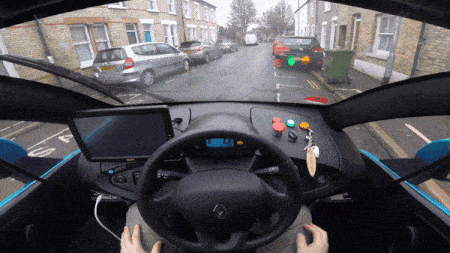For the first time, a single machine learning model began learning to drive two totally different types of vehicles: a passenger car and a delivery van. It was this artificial intelligence that was created Wayve, a London startup.
Because it is important
Less than a year ago, Wayve demonstrated that it could use artificial intelligence "training" on the streets of London, and use it to drive cars in four other English cities as well. Not long ago this goal would have required a lot of time and effort.
And it comes close to human behavior: after all, learning to drive regardless of place. You drive to your city, then you go to another city (maybe get a rental car) and you can drive anyway, right? I kept it simple, but in essence the news is that this technology is far, far ahead of current players like Tesla, Waymo and others.
A new generation that knows how to learn to drive
The difference between Wayve and the others is in the approach. It is a much smaller company than its better-funded competitors. But it is part of a new generation of startups, which some are calling “AV2.0,” which is abandoning the robotic mentality embraced by the first wave of companies developing autonomous vehicles.
Until recently, the approach was based on super-detailed 3D maps and separate modules for detection and planning. Waywe relies entirely on artificial intelligence to drive vehicles. In other words, the car has its own criteria for learning to drive, and adapts without having to resort to maps. Learn, interpret, put into practice.
Train and drive several different vehicles, even at the same time
The initial approach to autonomous vehicles he carried around a few prototypes, with great effort and cost. I don't know if it will spread in these terms. Wayve and other next-gen startups want to repeat with cars what deep learning has done for natural language processing.
Wayve vehicles are equipped with the same sensors as similar cars, but positioned higher up and at different angles. And the first difference catches the eye: with this approach, artificial intelligence manages everything. If I place these sensors on a small car, the AI calculates the difference in angle and “learns” to handle the different dimensions of a vehicle. Do I put these sensors in a truck? AI adapts to TIR. And it adapts to everything: size, mass, braking time, steering angle.
In other words: how a human being changes mode depending on the type of vehicle he drives. He “understands” that he is in another vehicle, and knows how to learn to drive accordingly. This has several consequences.

How this model of artificial intelligence works
The AI model from Wayve, Ghost and other next-gen startups is trained using a combination of reinforcement learning (where it learns through trial and error) and imitation learning (where it copies the actions of human drivers). It took thousands of hours of driving data to train the model to drive a car. Soon after, the AI was “put to drive” a van. Result? Only 80 hours. And she also got better at driving the car than before.
“I felt a little scared on the first ride of the van,” she admits Naomi Standard, the Wayve operator who was sitting in the driving seat, without driving. “I felt like a driving instructor with a novice student.” But the van coped well with London's narrow streets, navigating roadworks, pedestrian crossings, double-parked cars and other obstacles well.
Now imagine what will happen soon. These AIs will be placed on 20, 30 different types of vehicles, “re-learning” to drive on each of them in a slightly different way. And by putting these modalities together, we obtain a "general model" of driving.

The future: learning to drive
Ghost wants to make consumer vehicles that can drive alone on motorways; Wayve wants to be the first company to put driverless cars in 100 cities.
Both will contribute to a possible integrated future. An artificial intelligence service to which our autonomous vehicle will already be registered (a bit like a smartphone is equipped with an Android system): an artificial intelligence that will drive many vehicles at the same time, regulating their behavior in order to guarantee perfect safety.
Advanced artificial intelligence will create a standard, a single "brain" that will have control of everything that travels on the road: let's expect a long time for this, obviously. Not for technical reasons, though. For ethical and human reasons. A similar system, in fact, presupposes the existence of roads where no "human" vehicle can circulate. A non-negligible detail.
At least for now.


